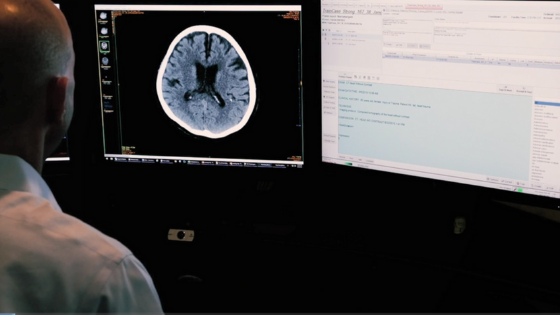How AI Is Accelerating Care Delivery in Critical Cases
The vRad Imaging Platform employs multiple AI models in processing over 20,000 radiology studies each day. Silently prioritizing critical cases is...

Remote radiologist jobs with flexible schedules, equitable pay, and the most advanced reading platform. Discover teleradiology at vRad.

Radiologist well-being matters. Explore how vRad takes action to prevent burnout with expert-led, confidential support through our partnership with VITAL WorkLife. Helping radiologists thrive.

Visit the vRad Blog for radiologist experiences at vRad, career resources, and more.

vRad provides radiology residents and fellows free radiology education resources for ABR boards, noon lectures, and CME.

Teleradiology services leader since 2001. See how vRad AI is helping deliver faster, higher-quality care for 50,000+ critical patients each year.

Subspecialist care for the women in your community. 48-hour screenings. 1-hour diagnostics. Comprehensive compliance and inspection support.

vRad’s stroke protocol auto-assigns stroke cases to the top of all available radiologists’ worklists, with requirements to be read next.

vRad’s unique teleradiology workflow for trauma studies delivers consistently fast turnaround times—even during periods of high volume.

vRad’s Operations Center is the central hub that ensures imaging studies and communications are handled efficiently and swiftly.

vRad is delivering faster radiology turnaround times for 40,000+ critical patients annually, using four unique strategies, including AI.
.jpg?width=1024&height=576&name=vRad-High-Quality-Patient-Care-1024x576%20(1).jpg)
vRad is developing and using AI to improve radiology quality assurance and reduce medical malpractice risk.

Now you can power your practice with the same fully integrated technology and support ecosystem we use. The vRad Platform.

Since developing and launching our first model in 2015, vRad has been at the forefront of AI in radiology.

Since 2010, vRad Radiology Education has provided high-quality radiology CME. Open to all radiologists, these 15-minute online modules are a convenient way to stay up to date on practical radiology topics.

Join vRad’s annual spring CME conference featuring top speakers and practical radiology topics.

vRad provides radiology residents and fellows free radiology education resources for ABR boards, noon lectures, and CME.

Academically oriented radiologists love practicing at vRad too. Check out the research published by vRad radiologists and team members.

Learn how vRad revolutionized radiology and has been at the forefront of innovation since 2001.

%20(2).jpg?width=1008&height=755&name=Copy%20of%20Mega%20Nav%20Images%202025%20(1008%20x%20755%20px)%20(2).jpg)

Visit the vRad blog for radiologist experiences at vRad, career resources, and more.


Explore our practice’s reading platform, breast imaging program, AI, and more. Plus, hear from vRad radiologists about what it’s like to practice at vRad.

Ready to be part of something meaningful? Explore team member careers at vRad.
2 min read
 Ricardo C. Cury, MD, FACR
:
March 7, 2018
Ricardo C. Cury, MD, FACR
:
March 7, 2018

Cardiovascular disease is the leading cause of death and disability in the world, killing 17.7 million people a year. That's a third of all deaths on the planet and half of all non-communicable-disease-related deaths. Cardiac imaging and vascular imaging are critical in foreseeing an event before it happens.
A coronary CT angiography (coronary CTA) uses an injection of iodine-rich contrast material and CT scanning to examine the arteries that supply blood to the heart and determine whether they have been narrowed by plaque buildup.
CAD-RADS™ – Coronary Artery Disease Reporting and Data System – is the language radiologists are developing to standardize the way we communicate with clinicians about coronary CT angiography (coronary CTA), facilitating better care decisions for cardiac patients.
The concept of a standard reporting and data system for a given pathology is not new, but the success of this approach has dramatically improved the speed and accuracy of diagnoses for other disorders, enabling faster, more informed treatment plans. It is time to apply the approach to coronary disease.
BI-RADS, the Breast Imaging Reporting and Data System, was first introduced in 1993 for mammography interpretations. Periodic refinements over its lifespan have evolved BI-RADS into an indispensible tool in advancing the detection and treatment of breast cancer. It has also inspired the successful development of other pathology-driven lexicons.
Following the BI-RADS model, we anticipate CAD-RADS will enhance communication between radiologists and clinicians regarding complex coronary CTA. The benefits include:
Coronary stenosis occurs when the coronary artery narrows due to plaque build-up. Eventually, this leads to limited blood supply to the heart muscle, and this can cause symptoms like chest pain as well as possibly heart attacks. Your treatment depends on the severity of your condition. CAD-RADS first categorizes coronary CTA images by coronary stenosis severity, using the Society of Cardiovascular CT (SCCT) classification system noted in the below table.
SCCT grading scale for stenosis severity
| Degree of luminal diameter stenosis | Terminology | CAD-RADS category |
| 0% | No visible stenosis | 0 |
| 1-24% | Minimal stenosis | 1 |
| 25-49% | Mild stenosis | 2 |
| 50-69% | Moderate stenosis | 3 |
| 70-99% | Severe stenosis | 4 |
| 100% | Occluded | 5 |
Then, based on whether the patient is presenting with stable chest pain or acute chest pain*, the radiologist may provide a clearly-defined interpretation, with guidelines for further cardiac investigation if necessary, and recommendations for emergent care or non-emergency treatment options.
*Acute chest pain, negative first troponin, negative or non-diagnostic electrocardiogram and low to intermediate risk (TIMI risk score <4) in emergency department or hospital setting.
Complete CAD-RADS categorization and guidelines are published in the Journal of Cardiovascular Computed Tomography. [Cury RC, et al., CAD-RADS™ Coronary Artery Disease e Reporting and Data System. An expert consensus document of the Society of Cardiovascular Computed Tomography (SCCT), the American College of Radiology (ACR) and the North American Society for Cardiovascular Imaging (NASCI). Endorsed by the American College of Cardiology. 2016]
Include CAD-RADS classification in every coronary CTA examination and final assessment. Educate Residency and Fellowship trainees in CAD-RADS terminology, assessment categories and management recommendations.
Through new scientific data, expert guidance from leaders in cardiac imaging, and a multi-disciplinary effort among radiology and cardiology societies, CAD-RADS will continue to evolve. As it does, we will speak the language of better education, compliant research, and more productive peer-review, with the ultimate goal of improved patient care.

The vRad Imaging Platform employs multiple AI models in processing over 20,000 radiology studies each day. Silently prioritizing critical cases is...
.png)
“Only a few more months and life will be good!” It’s the rallying cry of radiology residents and fellows everywhere. The idea that if we can just...
.png)
At some point in your career, if you are lucky, you find somebody approachable who’s blazed trails and navigated difficulties in ways you can model....
vRad (Virtual Radiologic) is a national radiology practice combining clinical excellence with cutting-edge technology development. Each year, we bring exceptional radiology care to millions of patients and empower healthcare providers with technology-driven solutions.
Non-Clinical Inquiries (Total Free):
800.737.0610
Outside U.S.:
011.1.952.595.1111
3600 Minnesota Drive, Suite 800
Edina, MN 55435